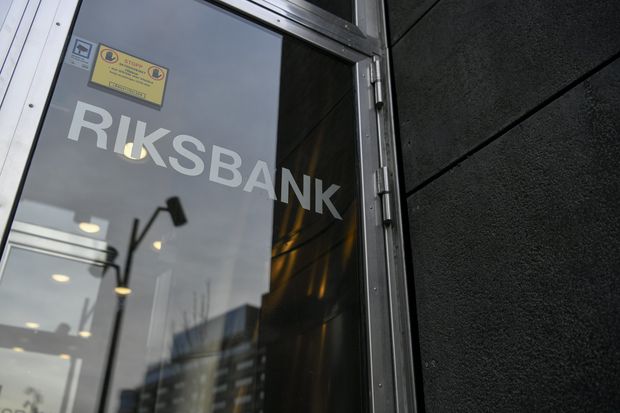
Sweden’s central bank on Thursday raised its policy rate back to zero, bringing an end to its experiment with negative interest rates. Photo: Mikael Sjoberg/Bloomberg News - Click to enlarge
Federal Reserve policy makers opposed to taking interest rates negative in the next recession might take comfort from the end of Sweden’s dalliance with below-zero rates.
But investors shouldn’t expect the neighboring eurozone to follow suit: Just hours after the Riksbank raised its policy rate back to zero on Thursday, a group of the most senior monetary-policy staff at the European Central Bank published a long-awaited paper robustly defending negative rates. The eye-catching claim: The benefits for the economy would still outweigh the damage even if rates went twice as negative, to minus 1%.
Sweden’s Riksbank warned of harmful side effects from prolonged periods below zero, even though it agrees with the ECB that negative rates have helped the economy so far by lowering borrowing costs and boosting inflation.
But which of them wins the argument about the future could be vital for the future use of rates below zero, something even the Fed might have to reconsider if they again hit zero in the next economic downturn.
SHARE YOUR THOUGHTS
Where do you land on negative rates? Good or bad, and why? Join the conversation below.
The disagreement is over what happens if rates stay low for a long time. In its monetary policy report on Thursday, the Riksbank said if negative rates are widely expected to last, “the behavior of economic agents may change and negative effects may arise.”
The side effects of negative rates have been well rehearsed by the skeptics: Bank margins are squeezed if they can’t pass on the negative rates to their own depositors; pension funds and insurers forced by regulators to hold negative-yielding government bonds will find it hard to meet promises to customers; and the prospect of better-than-free money may encourage financial and housing bubbles.
The Riksbank didn’t go into detail about its concerns. But the worries are serious enough for the central bank to raise rates even as it acknowledged that the economy was weakening—although it continues to buy bonds and promised no further rate increases for years.
The ECB paper led by
Massimo Rostagno,
head of the bank’s monetary policy division, insists that negative rates, alongside bond buying, forward guidance and cheap long-term loans to banks, provide multiple benefits.
First, it argues, demonstrating that there is no zero lower bound to rates takes away the fear that central banks are powerless to act when rates hit zero.
Second, negative rates—a charge on commercial bank deposits at the central bank—create a “hot potato” effect. Banks are encouraged to lend out or invest their money to avoid paying the ECB to hold their spare reserves. The banking system as a whole can’t escape the cost of negative rates, since the reserves have to end up back at the ECB in the end. But any individual bank with spare money can hope that if it is used to buy bonds or lent out, the recipient will pay it into an account at a rival, which will then have to take the hit from the ECB.
Third, the research found that cuts to rates when they are negative lower government bond yields more than cuts when they are positive. The biggest effect is on five-year bonds, which heavily affect fixed-rate lending. The explanation is tricky; one possibility that rather undermines the case for negative rates is that investors think things must be really bad for the central bank to try out even deeper negative rates, so expect rates to stay low for a long time. It’s easy for a central bank to cut rates in normal times, so they are usually expected to rebound toward a higher steady state within a few years.
Fourth, the negative rates helped other policies, such as forward guidance and corporate bond purchases, be more effective.
Finally, a model used in the study concludes that banks have made more money with negative rates than they would have if rates hadn’t been cut, and will continue to do so. This seemingly counterintuitive conclusion results because the squeeze on bank margins has been more than offset by rising fees, capital gains and lower provisions for losses than would have been the case.
It is possible to pick apart each point. But even for those who buy into the methodology, it is far from clear that negative rates are worth the uncertainty or the political angst. The study tries to break apart the effect on inflation and growth, and it concludes that negative rates were less effective than bond buying, forward guidance or cheap loans—and pushed up inflation by up to 0.07 percentage point a year (see chart).
Every little bit helps, and this is a conservative estimate. But the rewards seem small given the danger that prolonged negative rates could either inflate a bubble or start to hurt banks, insurers and pension funds.
I’m with the Riksbank: Negative rates can help the economy, but the side effects are likely to increase the longer they stay negative. So it’s best to keep it as a short-term experiment.
Copyright ©2019 Dow Jones & Company, Inc. All Rights Reserved. 87990cbe856818d5eddac44c7b1cdeb8
Full story here Are you the author? Previous post See more for Next postTags: newsletter





























